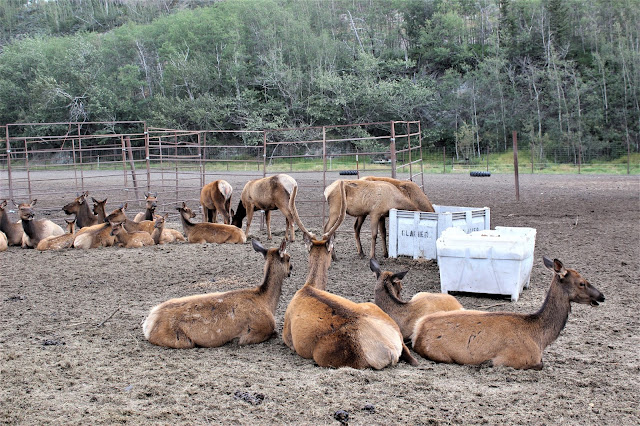My husband is a wildlife lover extraordinaire, and Alaska is certainly the place to see wildlife, but he wasn't content with seeing animals in the wild. No, he had to scout out every specialty farm and preserve. I was a little bit worried about OD-ing on animals on this trip, but for the most part, what we saw was unique and entertaining, starting with a musk ox farm and a reindeer ranch.
The Musk Ox Farm is in the Palmer/Wasilla area, about 45 minutes from Anchorage.
The farm is a non-profit organization that is funded partly by tourist dollars and partly by selling muskox wool, called qiviut. Qiviut is eight times warmer than sheep's wool by weight and softer than cashmere, but boy-oh-boy is it expensive. A single skein (1 oz./200 yards) sells for $95.00.
A male musk ox sheds 4-7 pounds of qiviut per season. I suppose if I had to brush one of these beasts, I'd charge $95.00/skein too.
For a more reasonable price of $11.00 each, we took a 45 minute tour of the farm, which has about 80 musk oxen, the largest captive herd in the world.
The musk ox is one of the oldest living species and was once a contemporary of the woolly mammoth and the saber-toothed tiger. The goal of the farm is to domesticate these animals. It takes multiple generations to build a domesticated herd, and they've been at it since the 1950s.
Musk oxen are native to the tundra, where temperatures average about -25 degrees F. in the winter and can be as cold as -85 degrees F. Musk oxen do not migrate like the caribou or hibernate like bears. They stick it out on the frozen tundra.
Our tour guide:
The moms and calves get the pasture closest to the farmhouse, probably so they can be watched over:
I have to say that musk ox calves are not the cutest babies in the animal world:
The bulls are sprinkled throughout several other pastures:
To be honest, I don't know which ones are male and which are female. This one has a macho American bison hairdo:
A close up of that fur coat. It looks coarse and wiry rather than soft, but I wasn't about to reach out and touch it:
We were warned several times not to get too close to the fence when a bull was nearby or he might charge us.
Musk ox hooves don't look like any other cattle hooves I've seen. They're more like Clydesdale horses
This poor guy/gal only had one horn:
Gee, they look so sweet, like they are waiting for the tourists to slip their hands filled with alfalfa pellets through the fence. Yeah, right!
Mannequin challenge, musk ox style:
Oops. I don't think Mama is happy about that idea. By the way, female reindeer (and caribou) grow antlers just like the males do, but they tend to shed them at different times of the year.
Reindeer and caribou are the same species, with the biggest difference being that reindeer have been domesticated for thousands of years. In general, reindeer are also not as large as caribou, which was certainly what we noticed in our encounters with both animals. The Palmer Reindeer Farm notes that on average, their reindeer are 8" to 10" shorter than caribou.
I thought sorting socks was hard, but imagine trying to sort out whose antlers are whose:
For a fee of $9/person, we were allowed to enter the pen with the reindeer and were given pellets to feed them. They were very friendly. No wonder Santa uses them for his sleigh:
Some of the antlers look like cartoon hands:
The teenage reindeer on the right appears to have Antler Envy:
We tried to get a picture we could use for a Christmas card, but the reindeer weren't very good at posing once they realized we had food in our cup:
Bob enjoyed rubbing them under their chins. They tolerated his lovin', hoping that it would end with something to eat:
. . . which it usually did:
It was high summer in Alaska, and some of these critters could have really used a salon visit:
The Reindeer Farm had a few other animals, including this massive American bison:
The musk ox and reindeer farms were fun and unique, not something we've ever seen anywhere else.






















































Musk oxen are only in the wild in places very far away from where we would be. Captive musk oxen were the only way we could see them. The reindeer farm was very close to the musk ox farm, so why not? Besides, there wasn't really anything else between Talkeetna and Anchorage and it gave us something to do.
ReplyDeleteI'm amazed that musk ox fur is used to make into yarns. Who was the first brave soul to figure out how to talk the ox into giving up his hairy-ness and try spinning it into wool?
ReplyDelete